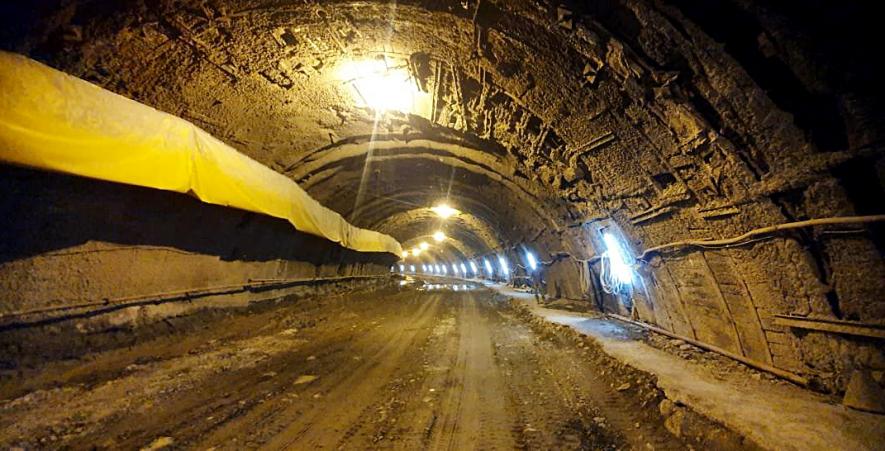Noted Environmentalist Red Flags Char Dham Project Dangers

Chamba Tunnel a part of Char Dham Road project
Noted Dehradun-based environmentalist Ravi Chopra recently resigned as the chairman of the Supreme Court (SC)-appointed High Powered Committee (HPC) overseeing the environmental impact of the Narendra Modi government’s Rs 12,000 crore 889-km Char Dham highway widening project in Uttarakhand.
The Char Dham project, one of the largest road-widening projects in the Himalayan region, intends to connect the four Hindu shrines of Gangotri, Yamunotri, Kedarnath and Badrinath.
In his resignation letter to the SC’s secretary general, Chopra expressed concern over the court’s December 14, 2021, judgement allowing the widening of 674 km of roads leading to the India-China border to 10 metres of tarred surface based on the double lane-paved shoulder (DL-PS) configuration. The judgement had modified the court’s September 8, 2020, order restricting road width on the highway to 5.5 metres.
Chopra has consistently maintained that a10-metre tarred road requires widening up to 12 metres and cutting mountains till 24 metres, leading to more damage to the forest and the environment. Besides, the ministry of road, transport and highways (MoRTH) could also seek legal relief for widening 151 km of non-defence roads as per DL-PS standards.
“By the judgment dated 14.12.2021, while recognising the hard work put in by the HPC, the Hon’ble Court has accepted the wider DL-PS configuration instead of what the order dated 08.09.2020 envisaged. The judgment has also confined the role of the HPC to overseeing the implementation of its recommendations for the project on the two non-defence roads only. In the circumstances, I do not see any purpose in continuing to head the HPC or indeed even to be a part of it,” Chopra’s letter states.
These two non-defence roads connect Rudraprayag to Kedarnath (70 km) and Dharasu to Janki Chati (70k km). The court has now entrusted the task of overseeing 70% of the work to the newly appointed Oversight Committee headed by retired SC judge Justice AK Sikri.
In his letter, Chopra expressed anguish at the way engineers (with no sensitivity towards the fragile Himalayas ) “armed with modern technological weapons slash through pristine forests, wounding vulnerable Himalayan slopes to widen highways. And the way ever-increasing numbers of tourists spew noxious gases that cover the towering peaks”. He cautioned that “nature, however, neither forgets nor forgives such wilful wrongs inflicted on her treasures. Already, we have witnessed stretches of roads disappear that have later taken months to repair”
In the debate of so-called ‘development versus environment, where the former usually wins, Chopra mentions, “Sustainable development demands approaches that are both geologically and ecologically sound. Such development also enhances disaster-resilience and hence national security, especially when climate challenges to slope stability are becoming far more unpredictable.”
In an exclusive interview with this reporter, Chopra talks about the contentious issue.
Do you think the ecology of the area has been affected by the Char Dham project and what could be its long-term impact?
Overall, the ecology has been gravely harmed. The slope destabilisation, soil erosion and sequestered carbon loss have increased over the years. Officially, 690 hectares of forestland have been diverted, which, according to the HPC’s estimation, led to the loss of 84,000 tonnes of sequestered carbon. Much more sequestered carbon has been lost due to unanticipated or unaccounted forest loss. Including the unaccounted forest loss of one hectare per km, as per the final report, 900 hectares have been diverted.
This will reduce CO2 absorption capacity, increase human-wildlife conflicts and result in the loss of some of the state’s finest deodar and oak forests. Several springs have been destroyed. The amount of actual muck generated is far greater than the anticipated estimate. A lot of muck has been illegally dumped into forestland, rivers and sometimes human settlements.
According to estimates, around like 32 million cubic metres of soil may have been lost. The increase in vehicular pollution will be particularly harmful to the narrow valleys at the end of Char Dham highways. It will lead to the deposition of black carbon soot on glaciers and most likely increase the melting of glaciers.
In terms of long-term impact, we will see more carbon sequestration impact and release of CO2, loss of springs and increase in chronic landslide zones and soil and water runoff.
Do you think the defence ministry’s requirement for wider roads could be met through a middle ground where detrimental effects on the environment could be minimised?
The committee [HPC] unanimously concluded that the environmental damage already done will significantly increase with the widening of roads and cutting of hills. The ministry of defence never asked for a 10-metre tarred surface or a 12-14-metre total width. It had only asked for a 7-metre tarred surface in its affidavit dated 30.11.20. The MoRTH asked for a 10-metre tarred surface.
According to rules, national highways where toll is charged should have 10 metres of tarred surface. MoRTH’s own engineers concluded in 2018 that national highways in mountainous terrains should be of intermediate width (5.5 metres) to reduce the kind of environmental challenges encountered earlier. An intermediate width of a 5.5-metre tarred surface allows smooth two-way traffic.
Why do you think the SC has suggested to MoRTH to seek legal relief for widening the 151 km of non-defence roads as per DL-PS standards?
I cannot read the SC’s mind. Having interacted with MoRTH engineers, I know that they will welcome this concession.
Do you think the project serves any interest of the local people or is beneficial to them?
It has certainly proved beneficial to local contractors. There are people in the hotel business who anticipate more tourists. Therefore, new hotels are coming up on the highway. But the local people, particularly whose area is being bypassed, are very unhappy and fear decline in future income from tourism. The problem of slope destabilisation in some stretches has worsened due to this project—in Gadora village, on the Rishikesh-Badrinath road, in Chamoli district, and Sirmuna village, on the Pithoragarh-Tanakpur road, NH1. The soil is creeping and the cracks have widened.
How was your tenure as HPC chairman? Any lessons learnt from the experience?
I think it is very important for people who head these kinds of committees to be alert to the politics of the committee and the project.
Get the latest reports & analysis with people's perspective on Protests, movements & deep analytical videos, discussions of the current affairs in your Telegram app. Subscribe to NewsClick's Telegram channel & get Real-Time updates on stories, as they get published on our website.
























